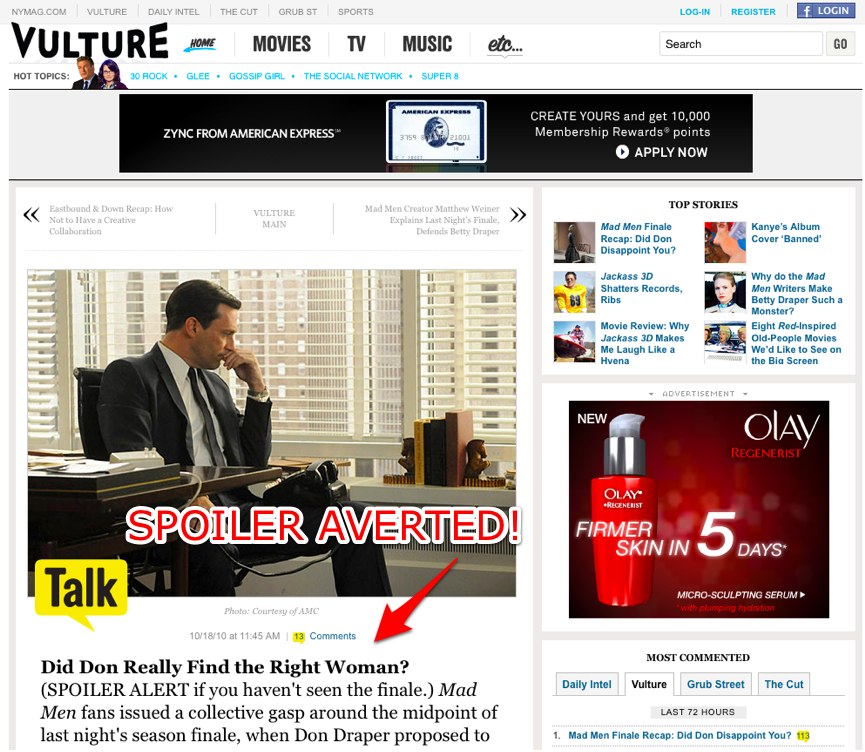Spoiler alert: collateral editing
October 18, 2010
Spoiler alert, you guys.
So New York Magazine’s Vulture blog posted a little ditty about whether or not Don Draper chose the right woman on Mad Men’s season finale, complete with an episode spoiler right in the headline: “Is Megan Really Right for Don?”
Spoilers in the headline? One comment summed it all up:
“It’d be awesome not to have spoilers in the headlines.”
Point taken, apparently: New York Magazine’s response was to change the headline.

Unfortunately, the headline doesn’t stand alone.
Updating Content = Updating Metadata
As with any content management system worth its licensing cost, posts on Vulture’s site are published with an automated simple URL. The assumption is that this URL becomes the permalink of the article, forever and ever, despite any changes in content or, in this case, the headline itself.
The headline was changed, but the URL remains the same. The result: a spoiler is only partially averted.

The lesson is simple: our blog posts and articles and Web pages are so much more than art and copy, and – especially in the case of a major news blog – we as writers and content specialists need to always remind ourselves that changes do not necessarily cascade throughout the metadata.
It’s not only a problem in the URL, either. When we update an article, do we also update the timestamp? Do we let the reader know the article has changed? Does it now fit under a different category, or are there different tags that can be assigned?
Updating an article or blog post or even a static HTML block of copy can range from a spelling correction to a major re-write or adjusted attribution. Different levels of change lead to different levels of updating.
That being said, all levels of updating require a quick confirmation that EVERYTHING has been updated. It’s something I forget on this blog every day. I’d be willing to guess it happens to you, too.
The “Change Everything” List
It’s one thing for this to happen on your little personal blog. But when it starts popping up in a major publication’s news feed, it becomes a larger (not to mention, more noticeable) problem.
Having a simple workflow in place to address post-publication changes can help catch the small things that might fall through the cracks. For example, when updating a blog post, a content wrangler should check:
A. URL – Does the URL still reflect the nature of the article?
B. Metadata – Tags, categories and other items of taxonomy – are they still valid?
C. Post Status – If the post has changed drastically, is there a way to flag the post as “changed” or “updated?”
D. Date/Time – Some CMS programs will automatically update the timestamp. Determine whether the timestamp needs to stay the same (in the event of a minor spelling change or other item of insignificance) or if the timestamp needs to be adjusted to reflect new information.
There’s more, too, depending on the level of journalistic integrity, what your CMS allows and what your readers expect. Adjust and administer as you see fit.
But What About Links?
Yeah. Good question.
In the case of this Vulture article, the headline itself was changed rather quickly – enough to think that, if the URL was also changed, it would still be in the initial stages of gathering inbound links.
But what about an article that’s a few hours old? A few days?
That answer ain’t simple, folks. It’s a matter of serious discussion, comparing the benefits of giving the post a more fitting URL with the risks of losing those inbound links.
Some CMS packages allow for single-page URL redirection. Most don’t – at least, not as a base function – and changing the URL runs the risk of leaving a sea of broken links, especially as an article moves further away from its original publish date.
In the case of this Vulture article, what seems like a URL mix-up may, in fact, be on purpose. If the article blew up early and garnered a large amount of traffic, the editorial staff may have said, “Hold on, buddy. Spoilers are a part of the business, and we’re a news-based blog, so let’s keep that URL and just change the headline.”
That being said, there’s a lot to be said about the editorial process before we even reach this kind of decision. If articles go through a solid set of checks and balances, there will no reason to get this far.
Boiling it Down
Above everything, the question of changing URLs after publication outlines the necessity of carefully reviewing content before it’s posted: a policy of steering clear of immediate spoilers, in this case, would have prevented the need for a URL change.
We can’t be perfect all the time, though. I know I can’t be.
So develop a quick checklist and apply it to all post-publish edits. Do it right now. It’ll take no more than 15 minutes, and it’ll save you from spoiling the finale of Mad Men for some unfortunate soul.
(Originally posted at Black Marks on Wood Pulp.)

